Timbuctoo Institute builds pipeline to environmental futures
“Transformative.”
That’s how Francisco Varela Hernandez described his experience with the Timbuctoo Climate Science and Careers Summer Institute last summer.
Varela Hernandez was among the 41 sophomore and junior high school students from the New York City area to participate in the immersive program created by ESF. The program isn’t just about learning climate science; it is a gateway to exploring future careers and tackling issues of equity and justice. Designed to open doors for students from systemically marginalized communities in the New York City area, it offers a unique blend of education and empowerment, at locations across upstate New York.
The Timbuctoo Institute journey starts in Brooklyn and winds its way through Kingston and Syracuse before culminating in the Adirondacks. Over two weeks, students dive into hands-on activities, experiential learning, and guided exploration, all under the mentorship of college faculty, research staff, and college students from ESF and CUNY Medgar Evers College (MEC), an institute partner.
Timbuctoo’s emphasis on interdisciplinary learning and real-world application inspired Varela Hernandez to connect environmental studies with his other academic interests of economics and computer science. As a result of his Timbuctoo experience, he plans to add an environmental science minor to his studies in college.
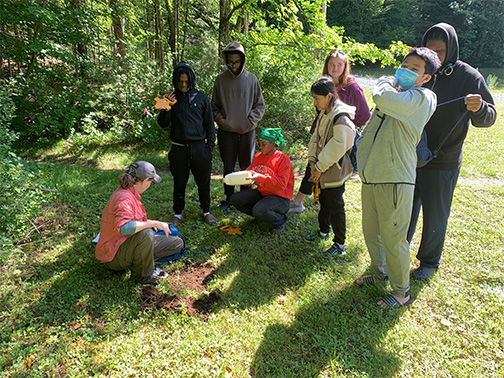
Participants learn about invasive earthworms ecologist and Associate Director Dr. Stacy McNulty ('97 & '23) at ESF's Newcomb Campus.
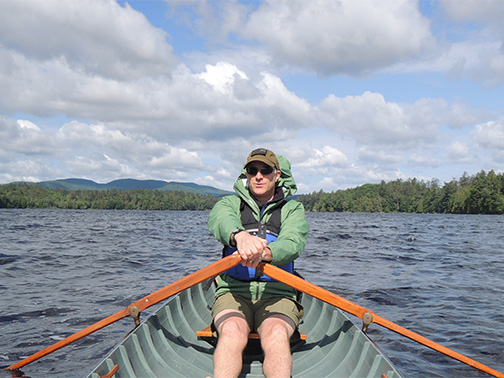
Associate Director and Timbuctoo creator Paul B. Hai ('00), rowing one of ESF's guide boats
A hallmark of the program is showing students there is a place for all interests in environmentalism.
“Before students decide on their future, we want to introduce them to a wide range of lesser-known career options,” said Paul Hai (’00, MS environmental and forest biology), associate director of the Adirondack Ecological Center in Newcomb and director of the Institute. “Our goal is to show students how they can merge their interests and skills with careers in climate, environment and natural resources, from public policy to research, community action to college instruction and beyond.”
The Institute explores this through a lens of environmental justice, social justice, and climate science, while highlighting intersectionality. For example, someone passionate about writing and the environment could become an environmental journalist. Or those interested in climate issues and the arts could engage people through visual mediums to focus on climate and social justice.
The Institute helps open doors for students, creating pathways to academic and professional careers in environmental fields. By collaborating with partners such as the New York State Department of Environmental Conservation and its various divisions within DEC, students can build a network of opportunities. The program introduced students to a wide range of people from politicians to park rangers. This initiative is all about fostering awareness and access, helping students discover and pursue their passions in the environmental sector.
“The Timbuctoo program showed me a great deal of what being an environmentalist was and that there is no one way to portray environmentalism,” said student participant Alima Djibo who was able to meet and network with environmental professionals from her area who looked like her.
“Even talking with the different staff and participants has helped me to realize there is no one way to care about the environment.” Djibo said.
Connecting students with people already in these spaces is one way to address a systemic issue. “We want to tackle the long-standing challenge of diversifying the people in leadership and decision-making roles across organizations, institutes, and agencies involved in natural resource management, conservation, and education,” said Hai, who noted these are all places where ESF graduates work, and the Institute provides a way to increase representation. “We’ve struggled with this lack of diversity for years and acknowledged it as a challenge.”
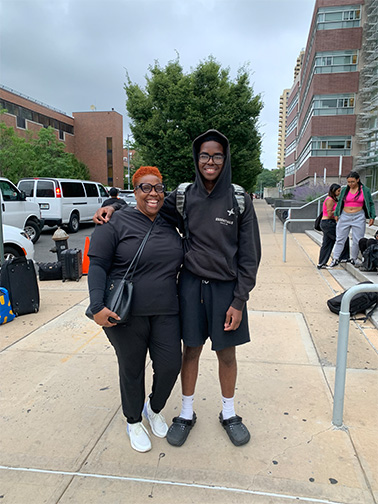
Participants and parents reunited at Medger Evers College, Brooklyn after a fabulous experience
The Adirondacks are the perfect setting to tackle this challenge. The Park was a cradle of the early civil rights movement, dating back to the mid-1800s. Specifically, Timbuctoo, outside of Lake Placid, was the site of an early black suffrage settlement, one of several known settlements in the Adirondacks that enabled 3,000 black men to meet the property requirements granting them the right to vote in New York state. This history of creating opportunity at Timbuctoo, specifically access to the vote, is honored and celebrated by creating a modern Timbuctoo pipeline to a different kind of empowerment. Now, through the Institute, the Timbuctoo pipeline is connecting youth to opportunities at the intersection of climate science and green careers, preparing them for the threats and opportunities of the 21st century.
“There’s an intentionality with the name,” said Hai.
Using real-world examples is one way they are showcasing career possibilities to the students.
“When we’re in Brooklyn, we meet with Forest Ranger John Scott, a Ranger of color, and they can see that career in their backyard,” said Hai. “And next to them, they see a student from ESF who’s going into resource management as a career because they want to be a Ranger. That opens their eyes to a career path that they may not have considered or known about before.”

Timbuctoo participants meet NYS DEC Forest Ranger Scott Sabo, learning about the roles and responsibilities of being a forest ranger.
A senior at World View High School in the Bronx, Djibo is thinking about her future and how she’s going to fit into the world.
“In all the routes I had in my head, everything is connected toward either helping other people or helping the environment,” she said. While she doesn’t know specifically what path she will take, she knows Timbuctoo had an impact.
“Before Timbuctoo, a big goal of mine was to become rich by whatever means possible,” she said. “After the program, I don’t find wealth to be the end-all, be-all of life.”
That realization came after the group learned about the impact larger economies have on climate and how people living in smaller economies live with the effects.

Participants and staff at the Skä•noñh Great Law of Peace Center, Syracuse, NY
“The lesson made sense,” Djibo said. “It wasn’t groundbreaking but realizing that made it clear the way things are happening in our country may not be the right or most just way. This made me think about my life and goals, what they were driven by, and the things my goal of being rich would contribute to. It made me think about life and myself differently.”
The Institute continues to impact the lives of its participants, as organizers hire program alumni. By hiring past participants and college students as summer staff, they are layering awareness, access, and opportunity immediately on the job-creation level, said Hai. “We want the participating students to see near-peer mentors from ESF and Medgar Evers.”
Varela Hernandez will join the Institute as a program assistant this summer. He was one of four program alumni who applied for staff positions this year and is excited to rejoin the program.
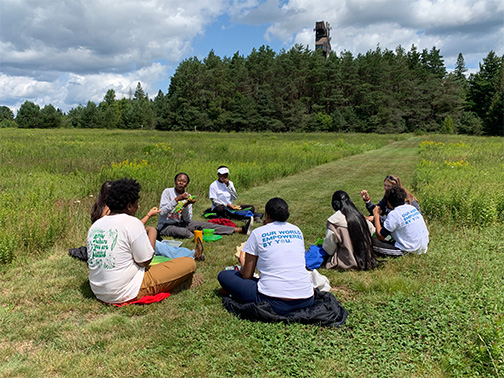
Participants enjoying lunch at John Brown's Farm, part of the settlement of Timbuctoo, in Lake Placid, NY
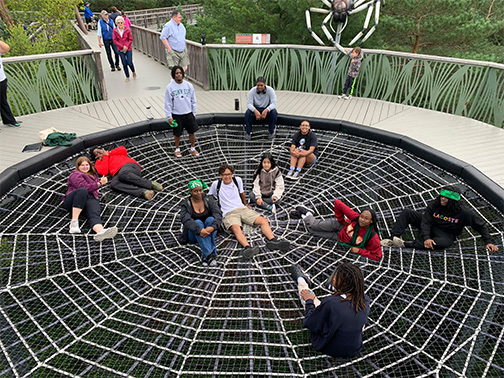
Participants exploring the spider's web along the Wild Center's Wild Walk, Tupper Lake, NY
“I believe in Timbuctoo’s mission wholeheartedly,” he said. “I’m committed to giving back to the institution that has given me so much. As an alumnus, I feel a sense of responsibility to pay it forward and contribute to the success of future generations of students.”
“The idea is to create near-peers of individuals that are walking a path that these participating students can say, ‘I can do that too. They’re someone who’s doing what I want to do,’ and they can make that connection.”
Although the program is only in its second year, early results are promising. Along with those who applied for staff positions, last year, seven participants applied to ESF, according to Hai. Notably, none of these students were aware of ESF before attending the Institute.
“The key for us was if you put alternatives in front of people, they respond,” said Hai.
This year’s New York state budget includes $1.2 million in additional funding for the Timbuctoo Institute, highlighting its importance. The Institute also received funding in the 2023 and 2024 state budgets. This support will help expand the program, increasing access for students and helping to bring new and diverse groups into the environmental field.


